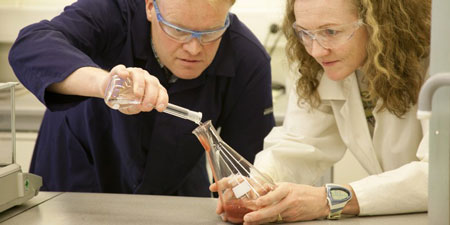In order to successfully convert biomass into fuel, researchers have developed a roadmap of chemical reactions. Each of these reactions requires either a different catalytic material or a different set of reaction conditions to work effectively.
Aug 9th, 2013
Read more
 Scientists have developed a method that accurately predicts the adsorptive properties of crystalline MTV-MOF systems synthesized with different combinations of functional chemical groups.
Scientists have developed a method that accurately predicts the adsorptive properties of crystalline MTV-MOF systems synthesized with different combinations of functional chemical groups.
Aug 9th, 2013
Read more
 A new cost-effective polymer membrane can decrease the cost of alkaline batteries and fuel cells by allowing the replacement of expensive platinum catalysts without sacrificing important aspects of performance, according to Penn State researchers.
A new cost-effective polymer membrane can decrease the cost of alkaline batteries and fuel cells by allowing the replacement of expensive platinum catalysts without sacrificing important aspects of performance, according to Penn State researchers.
Aug 7th, 2013
Read more
 A new process can convert a wide variety of vegetable and animal fats and oils - ranging from lard to waste cooking oil - into a key ingredient for making plastics that currently comes from petroleum.
A new process can convert a wide variety of vegetable and animal fats and oils - ranging from lard to waste cooking oil - into a key ingredient for making plastics that currently comes from petroleum.
Aug 7th, 2013
Read more
Scientists have developed a new understanding of how turbulence works, which could help to optimise vehicle performance and save billions in global energy costs.
Aug 7th, 2013
Read more
 For the first time anywhere, electric buses provide public transportation services and are recharged right from the road.
For the first time anywhere, electric buses provide public transportation services and are recharged right from the road.
Aug 6th, 2013
Read more
The Energy Department's National Renewable Energy Laboratory has published a report on the land use requirements of solar power plants based on actual land-use practices from existing solar facilities.
Aug 6th, 2013
Read more
Scientists at the National Physical Laboratory are helping to create electronics capabilities for electric vehicles, with the development of a high temperature capacitor.
Aug 6th, 2013
Read more
Researchers for EU-funded project GLOBAL-IQ ('Impact Quantification of Global Changes') are contributing to the debate by assessing the socio-economic impacts of climate change on society. They will also evaluate the costs and benefits of possible mitigation and adaptation strategies.
Aug 6th, 2013
Read more
 In 2012, wind energy became the number one source of new U.S. electricity generation capacity for the first time - representing 43 percent of all new electric additions and accounting for $25 billion in U.S. investment.
In 2012, wind energy became the number one source of new U.S. electricity generation capacity for the first time - representing 43 percent of all new electric additions and accounting for $25 billion in U.S. investment.
Aug 6th, 2013
Read more
 Norwegian scientists want to develop greener and more vigorous batteries, using inexpensive raw materials that are plentiful in Norway.
Norwegian scientists want to develop greener and more vigorous batteries, using inexpensive raw materials that are plentiful in Norway.
Aug 6th, 2013
Read more
Warming oceans are causing marine species to change breeding times and shift homes with expected substantial consequences for the broader marine landscape, according to a new global study.
Aug 4th, 2013
Read more
 Researchers describe a novel process to cut down on heat loss during the winter and keep buildings cool during the summer. Their 'bio-inspired approach to thermal control for cooling (or heating) building window surfaces' calls for attaching optically clear, flexible elastomer sheets, bonded to regular glass window panes.
Researchers describe a novel process to cut down on heat loss during the winter and keep buildings cool during the summer. Their 'bio-inspired approach to thermal control for cooling (or heating) building window surfaces' calls for attaching optically clear, flexible elastomer sheets, bonded to regular glass window panes.
Aug 2nd, 2013
Read more
The overall aim of the EU-funded CLIMSAVE project, ('Climate change integrated assessment methodology for cross-sectoral adaptation and vulnerability in Europe'), is to help in the assessment of the impact of climate change over a range of environmental and economic areas in different regions.
Aug 2nd, 2013
Read more
 Although e-vehicles make up only a tiny fraction of the European car fleet at present, sales are expected to grow exponentially over the coming years, thanks, in no small measure, to advances in e-vehicle technology.
Although e-vehicles make up only a tiny fraction of the European car fleet at present, sales are expected to grow exponentially over the coming years, thanks, in no small measure, to advances in e-vehicle technology.
Aug 2nd, 2013
Read more
 A University of Colorado Boulder team has developed a radically new technique that uses the power of sunlight to efficiently split water into its components of hydrogen and oxygen, paving the way for the broad use of hydrogen as a clean, green fuel.
A University of Colorado Boulder team has developed a radically new technique that uses the power of sunlight to efficiently split water into its components of hydrogen and oxygen, paving the way for the broad use of hydrogen as a clean, green fuel.
Aug 1st, 2013
Read more
Technology may one day be used to charge electric vehicles as they drive on highway, allowing unlimited range.
Jul 31st, 2013
Read more
Researchers have successfully produced bioethanol from waste paper, as part of efforts to turn waste into valuable products.
Jul 31st, 2013
Read more

 Subscribe to our Cleantech News feed
Subscribe to our Cleantech News feed







